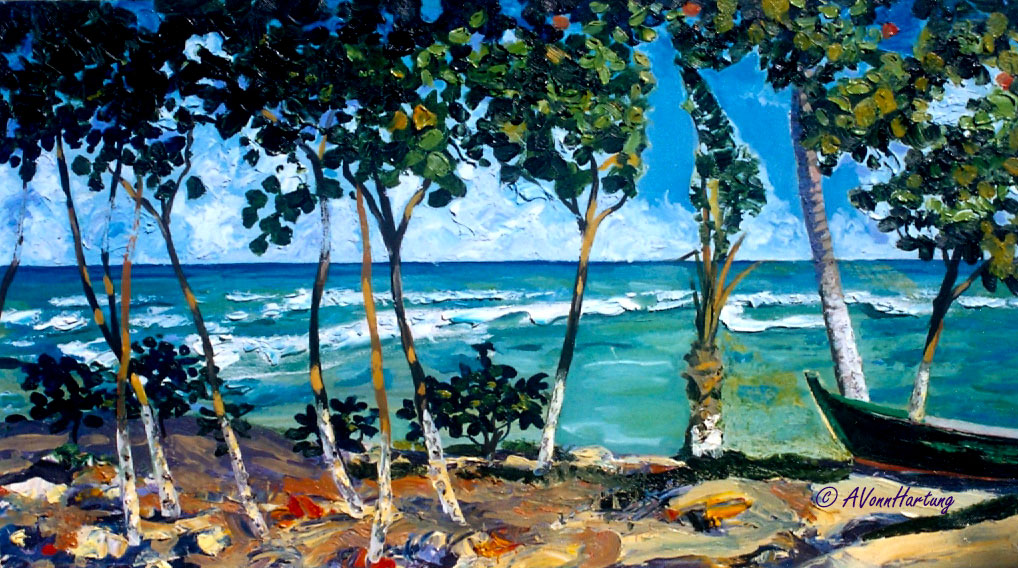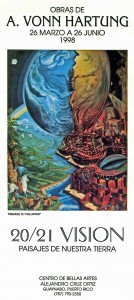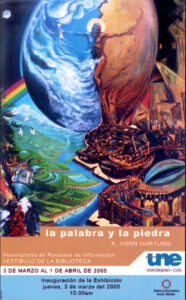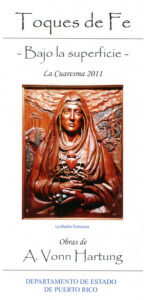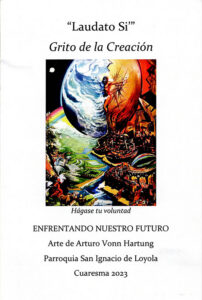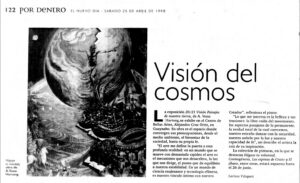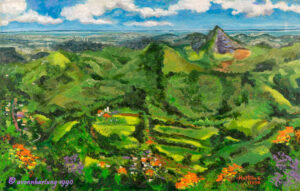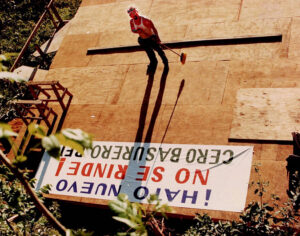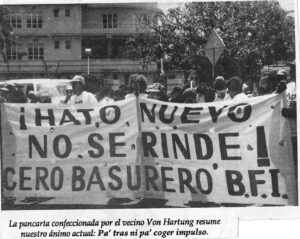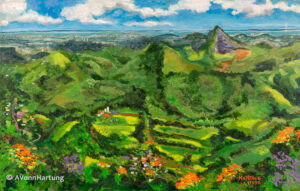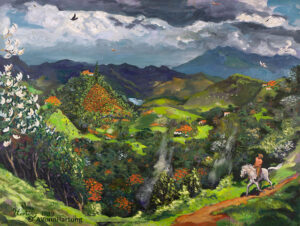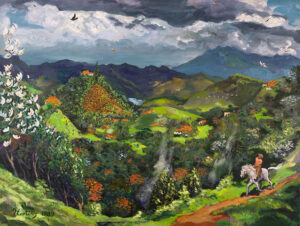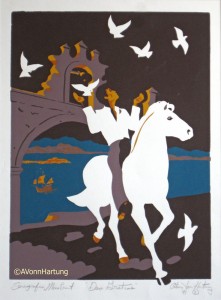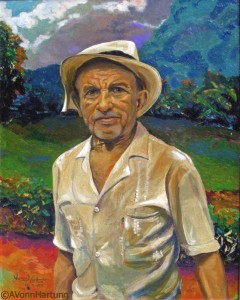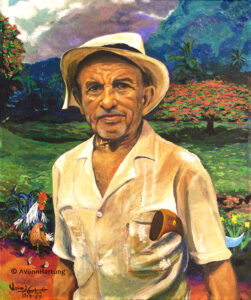Art Exhibits—A.Vonn Hartung
2021 Visión: Paisajes de Nuestra Tierra
Inauguracion del Centro de Bellas Artes Alejandro Cruz Ortiz
Guaynabo, Puerto Rico
26 marzo a 26 junio 1998
Estas obras representan para mí la transmisión de una visión artística, una visión que va desarrollándose, que yo experimento en el cosmos en comunión espiritual con la cultura y la vida natural con mis vecinos.
These works represent to me the transmission of an artistic vision. This vision is unfolding, one I experience in the cosmos through spiritual communion with the culture and natural life of my neighbors.
La Palabra y la Piedra
Universidad del Este Ana G Méndez, Carolina, Puerto Rico
3 marzo a 1 abril 2005 (durante Cuaresma)
En la exposición Vonn Hartung presenta el enfoque de su obra,en la cual se refleja el amor por la naturaleza, la búsqueda de los valores fundamentales de los seres humanos y la afirmación de la presencia espiritual en todo lo creado.
In the exhibition, Vonn Hartung presents the focus of his work, which reflects his love of nature, the search for fundamental human values, and the affirmation of the spiritual presence in all creation.
Toques de Fe: Bajo la Superficie
Departamento del Estado
San Juan, Puerto Rico
31 marzo a 21 abril 2011
(durante Cuaresma)
“Toques de Fe: Bajo la Superficie” explora esas imágenes de la fe tal como yo las entiendo e intento hacerlas visibles en sus manifestaciones interiores y externas. Cedo mi lugar a mis propias obras para alcanzar entendimiento, ya que ellas comunican de manera universal a través del lenguaje del arte y el simbolismo. Con la esperanza de que abrirá ventanas y puertas hacia esa luz brillante que he encontrado por medio de la fe en la belleza de las imágenes que hablan el lenguaje del espíritu.
“Touches of Faith: Beneath the Surface” explores these images of faith as I understand them and attempts to make them visible in their inner and outer manifestations. I surrender to my own works, which strive to achieve understanding, as they communicate universally through the language of art and symbolism. In doing so, I hope that they will open windows and doors to the brilliant light I have found through faith in the beauty of images that speak the language of the spirit.
Laudato Si’: Grito de la Creación
Parroquia San Ignacio de Loyola
San Juan, Puerto Rico
3 marzo a 25 mayo 2023 (durante Cuaresma y más)
Inauguración 22 abril
(Dia de Planeta Tierra)
Para celebrar el Día de la Tierra, el artista A. Vonn Hartung presentó su exposición “Laudato Si’— Cuidar la Casa Común” en la Iglesia San Ignacio de San Juan el 22 de abril de 2023. Con ocho obras principales, su propósito fue capturar la esencia y el espíritu de la encíclica del Papa Francisco, que llama a la atención mundial sobre la urgente necesidad de la gestión ambiental y la acción climática. Las obras de arte que invitan a la reflexión sirvieron como un conmovedor recordatorio de nuestra responsabilidad compartida de cuidar nuestro planeta y a los demás.
In celebration of Earth Day, artist A.Vonn Hartung unveiled his “Laudato Si’—Care for our Common Home” at San Ignacio Church in San Juan on April 22, 2023. Featuring eight major works, his exhibit aimed to capture the essence and spirit of Pope Francis’s encyclical, which calls for global attention to the urgent need for environmental stewardship and climate action. The thought-provoking artworks served as a poignant reminder of our shared responsibility to care for our planet and one another.
Works by A.Vonn Hartung
permanently displayed in Catholic Churches—
Casa de Niños Manuel Fernández Juncos (capilla), Miramar, San Juan, Puerto Rico
—La Madre Dolorosa, High Relief Wood Sculpture, 33 x 27 inches, Pau Lope wood, commissioned by Padre Julio Victor Garcia, 1991
—Sagrario “He is Risen” 20 x 14 x 12-inches, high relief wood sculpture on the door of Sagrario, commissioned by Padre Jorge Castillejo, 1992
—Altar and Ambo, high relief wood sculpture, Pau Lope wood, commissioned by Padre Jorge Castillejo, 1992
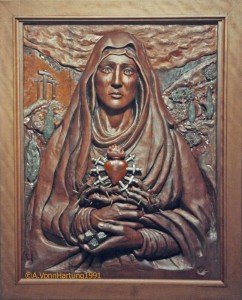
Parroquia San Francisco Javier, Urb Fairview, Trujillo Alto, Puerto Rico
—San Francisco Javier Baptizing, painting on wood panel, 7 x 11 feet, altarpiece (retablo), commissioned by Padre Julio Victor Garcia, 2002
—Vivimos para esa Noche (Beato Carlos Manuel Rodriguez Santiago), oil portrait on canvas, commissioned by Padre Julio Victor Garcia, 2000
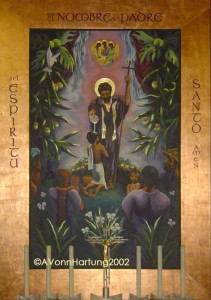
Hermanas Misioneras del Buen Pastor, Caguas, Puerto Rico
—El Buen Pastor / The Lost Sheep, painted mural on canvas (after Alfred Soord, The Lost Sheep), 9 x 12 feet, Sanctuary of Capilla, commissioned by las Hermanas Misioneras del Buen Pastor, circa 1986
—Las Huellas del Buen Pastor, oil painting (small mural), 40 x 60 inches, commissioned by las Hermanas Misioneras del Buen Pastor, 1995
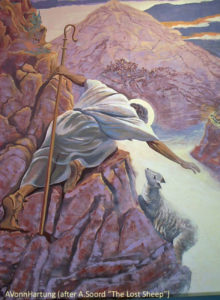
Parroquia El Buen Pastor, Guaynabo (Apolo), Puerto Rico
—El Buen Pastor, a painting on wood panel, 4 x 8 feet, commissioned by Padre Jaime Vazquez Rojas, 2003
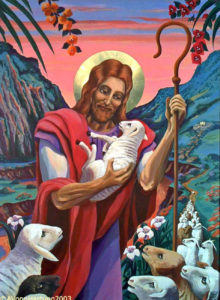
Parroquia Santa Rosa de Lima, Guaynabo (Barrio Amelia), Puerto Rico
—A Mural of Faith: Art in the Light of Christ, a painted mural in the Sanctuary, 29 x 65 feet, commissioned by Padre Julio Victor Garcia, 1997.
—Stations of the Cross, 14 painted panels, each 4 x 8 feet (gilded with gold and copper leaf) in the nave, commissioned by Mons. Antonio “Tito” José Vázquez, 2001
—Cordero 2, wood carving (for Sagrario), commissioned by Padre José Gregorio Guaipo
—Fourteen Stations of the Resurrection, giclee prints on wood panels, Padre José Gregorio Guaipo
—Beato Carlos Manuel Rodríguez Santiago, large giclee print on canvas, Padre José Gregorio Guaipo
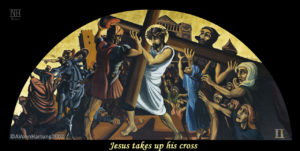
Parroquia Maria Auxiliadora, La Cantera, Hato Rey, Puerto Rico
—La Misericordia de San Juan Bosco, painting on wood panel, 3 ½ x 8 feet, commissioned by Padre Nicolás “Colacho” Navarro SDB, 2011
—San Juan Bosco blesses his successor, Blessed Michael Rua, painting on a wood panel, 3 ½ x 8 feet, commissioned by Padre Nicolás “Colacho” Navarro SDB, 2011
—Santo Domingo Savio (4 paintings on wood panels), in the side altars of the Sanctuary, commissioned by Padre Nicolás “Colacho” Navarro SDB, 2014
—Forever Young, a 27 square foot painting for the students of Colegio San Juan Bosco at Parroquia Maria Auxiliadora, commissioned by Padre Jorge Santiago Cartagena SDB, 2017
—Fourteen Stations of the Resurrection, large giclee prints on wood panels, commissioned by Padre Nicolás “Colacho” Navarro SDB, 2018
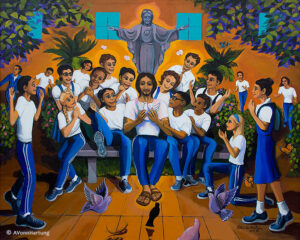
Colegio Maria Auxiliadora (in capilla), Santurce, Puerto Rico
—Mi Vida es para los Jovenes, vitral (oil paint on Lexan), commissioned by Sor Estela Baez y las Hermanas Salesianas, circa 2003.
—Santa Maria Mazzarello, vitral (oil paint on Lexan), commissioned by Sor Estela Baez y las Hermanas Salesianas, circa 2003.
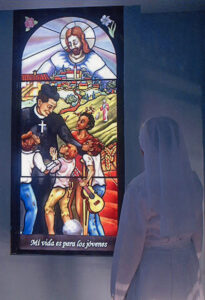
Parroquia San Juan Bosco, Villa Palmeras (Calle Lutz), San Juan, Puerto Rico
—Ten Stations of the Resurrection, vitrales (oil paint on Lexan), commissioned by Padre Luis Gomez SDB, circa 2005.

Parroquia San Juan Bautista, Orocovis (pueblo), Puerto Rico
—La Vida y Profecia de San Juan Bautista (The Life and Prophecy of St. John the Baptist), mosaic mural, 500 square feet in three arches, Sanctuary, commissioned by Padre Jorge Santiago Cartagena SDB
—Last Supper (oil paint on Lexan), in Santisima Chapel, commissioned by Padre Jorge Santiago Cartagena SDB
—El Pan y el Vino (two “stained glass” windows, oil paint on Lexan) in Santisima Chapel, commissioned by Padre Jorge Santiago Cartagena SDB
—Resurrección (stained glass window) in Santisima Chapel, commissioned by Padre Jorge Santiago Cartagena SDB
—El Nacimiento de San Juan Bautista (three “stained glass” windows, oil paint on Lexan) in Sacristy, commissioned by Padre Jorge Santiago Cartagena SDB
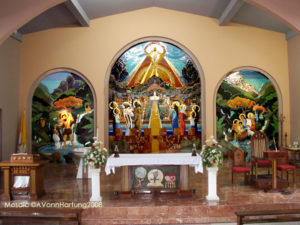
Capilla San Juan Bosco, Orocovis (Barrio Gato), Puerto Rico
—El Sueño de las Dos Columnas (Dream of the Two Columns), a painted mural in the Sanctuary of Capilla, 18 x 50 feet, commissioned by Padre Jorge Santiago Cartagena SDB
—Fourteen Stations of the Resurrection, “stained glass” windows—oil paint on Lexan, commissioned by Padre Jorge Santiago Cartagena SDB
—Two large “vitrales” (theme of the mural “Dream of the Two Columns”), oil paint on Lexan, commissioned by Padre Jorge Santiago Cartagena SDB
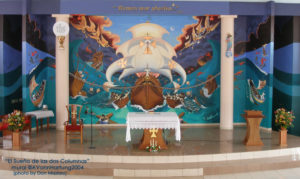
Capilla Divino Niño Jesús, Orocovis (Botijas), Puerto Rico
—San José con el Niño Jesús, acrylic painting on wood panel, in the Sanctuary, commissioned by Padre Demetrio Coello SDB and the Salesian community.
—Jesús Resucitado, acrylic painting on wood panel, in the Sanctuary, commissioned by Padre Demetrio Coello SDB and the Salesian community.
—Maria Auxiliadora, acrylic painting on wood panel, in the Sanctuary, commissioned by Padre Demetrio Coello SDB and the Salesian community.
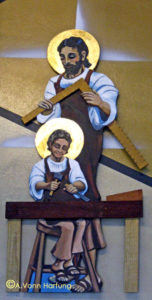
Catedral San Juan Bautista, Viejo San Juan, Puerto Rico
—Stations of the Resurrection, 14 paintings on wood panels, 24 x 24 inches, 2015, on loan from the artist, A.Vonn Hartung, to Mons Roberto Gonzalez Nieves, 2018 (NOTE: Giclee prints of these paintings are on display in several churches in Puerto Rico.)
—Carved Andas, (for processions) commissioned by Mons Roberto Gonzalez Nieves with liturgical consultant Hector Balvanera, 2015
—Misericordia, a painting on wood panel, 2015, commissioned by the Archbishop of San Juan, S.E.R. Monseñor Roberto González Nieves, for the arch above the main doors of Catedral San Juan Bautista in San Juan, Puerto Rico, to commemorate Pope Francis’ declared Extraordinary Jubilee Year of Mercy 2015-2016. Liturgical consultant Hector Balvanera.
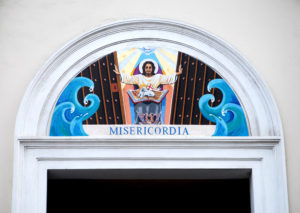
Capilla María Auxiliadora, Carolina (rural), Puerto Rico
—Saint Joseph, Protector, carved statue, approximately 3 feet high, in Capilla, commissioned by Padre Rafael de Jesús Gonzalez Ayala CRL, 2017
—Beato Carlos Manuel Rodríguez Santiago, giclee print on canvas, Padre Rafael de Jesús Gonzalez Ayala CRL, 2017
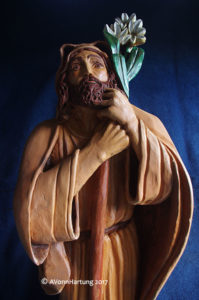
Catedral Dulce Nombre de Jesús, Caguas, Puerto Rico
—Cordero, wood carving for Beato Carlos Manuel Rodriguez’s tomb, commissioned by Mons. Ruben Antonio Gonzalez Medina CMF, 2001
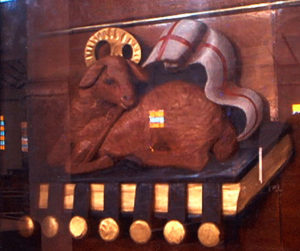
Parroquia Maria Madre de mi Señor, Guaynabo, Puerto Rico
—Before Birth: Mary at the Manger, acrylic painting on canvas, 24 x 36 inches, commissioned by Padre Jairo Granados, 2021
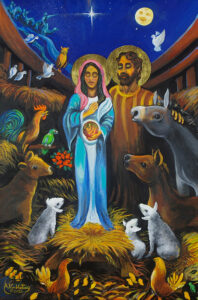
Parroquia Corazón de Jesús, Guaynabo, Puerto Rico
—Fourteen Stations of the Cross, Giclee prints mounted on wood panel, commissioned by Padre Phillip (Felipe) Nuñez, 2020
— Fourteen Stations of the Resurrection, Giclee prints mounted on wood panel, commissioned by Padre Phillip (Felipe) Nuñez, 2020
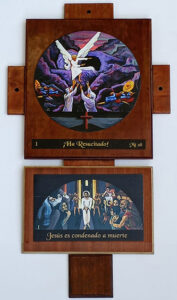
Parroquia San Ignacio de Loyola, San Juan, Puerto Rico
—Replica of high relief ceramic sculpture St Benedict of Nursia, 32 x 11 x 3 inches, Forton Hydrocal (architectural stone), Rev. Ron Gonzales, SJ
—Replica of high relief ceramic sculpture, St Francis of Assisi, 32 x 11 x 3 inches, Forton Hydrocal (architectural stone), Rev. Ron Gonzales, SJ
—Replica of high relief ceramic sculpture, St Ignatius of Loyola, 32 x 11 x 3 inches, Forton Hydrocal (architectural stone), Rev. Ron Gonzales, SJ
—Our Lady of Guadalupe with San Juan Diego, oil painting on canvas, commissioned by Parroquia San Ignacio (9:30 Community) in San Juan, Puerto Rico, 2003
—Fourteen Stations of the Resurrection, giclee prints mounted on wood, Father Lawrence Searles SJ, 2018
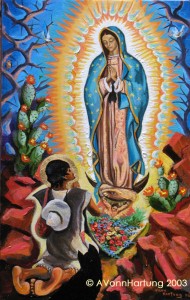
Salesianos Aibonito (capilla), Puerto Rico
—Ten Stations of the Resurrection, giclee prints on wood, commissioned by Padre Demetrio Coello SDB and the Salesian community.
—Bread and wine, wood carving for altar, commissioned by Padre Demetrio Coello SDB and the Salesian community.
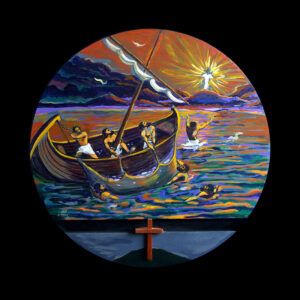
Parroquia Santa Luisa de Marillac, Rio Piedras, Puerto Rico
—Fourteen Stations of the Resurrection, giclee prints on wood, Padre Tomás G. Gonzalez, 2020
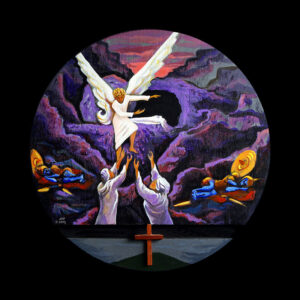
***************************************************************
St. Joseph Church, New London, Connecticut
—Saint Dymphna, Life-size statue, Cedro odorata, Commissioned by Father Mark O’Donnell, 2021
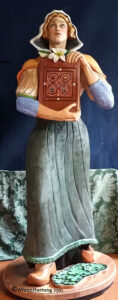
Our Lady of Lourdes Church, Gales Ferry, Connecticut
—Baptism, Life-size high relief wood sculpture, Linden wood, commissioned by Our Lady of Lourdes Church, circa 1983
—Last Supper, Life-size high relief wood sculpture, Linden wood, commissioned by Our Lady of Lourdes Church, circa 1983
—Carved Hymn board, 4 x 6 feet (opened), Honduran Mahogany, commissioned by Our Lady of Lourdes Church, circa 1983
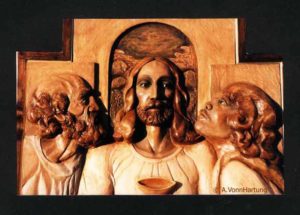
St. John Church, Montville, Connecticut
Crucified Christ, Life-size on a 10-foot cross, Linden Wood and Mahogany, commissioned by Monsignor Bronislaw Gadarowski, 1981
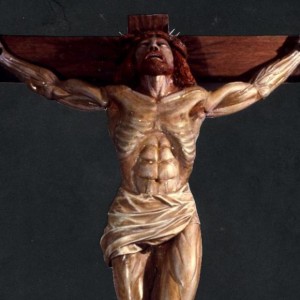
St. Paul Church, Pensacola, Florida
Six Carved Saints (Paul, Peter, Matthew, Mark, Luke, and John), high relief wood sculptures (12-inches x 33-inches x 3-inches) for the ambo, commissioned by Pastor Doug Halsema with liturgical consultant Steven Schloeder, 2008
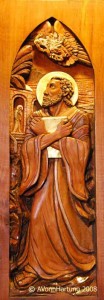
Pontifical North American College, Vatican
Beato Carlos Manuel Rodriguez Santiago, painting on canvas, 34 x 26 inches, in the Hall of Saints, commissioned by Mons Roberto Gonzalez Nieves, Archbishop of San Juan, 2001
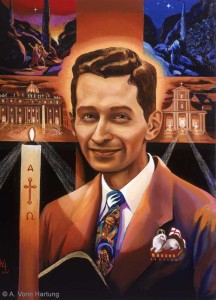
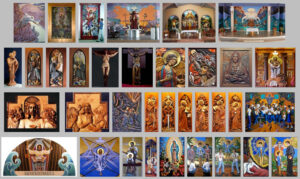
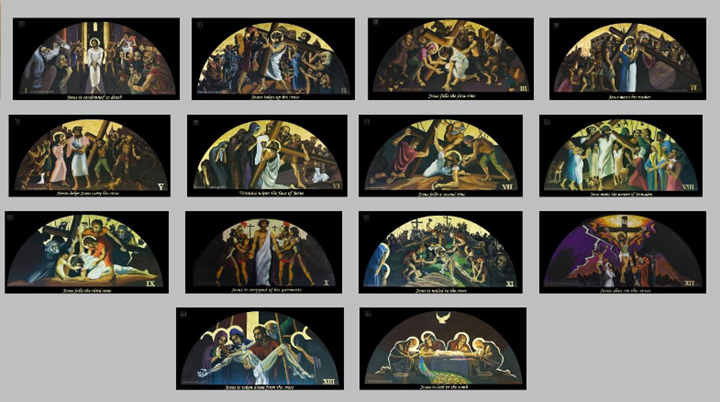
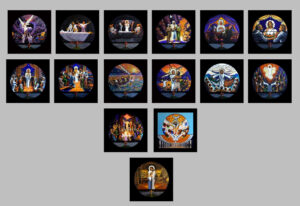
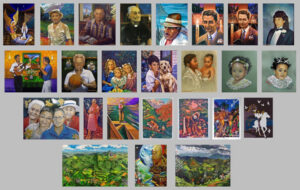
AVonnHartung_interview-by-El-Visitante-Catholic-Newspaper-Puerto-Rico
Symbolist of the Sacred_NL Day article 1997
LosSurcoVitalesDeVonnHartung_el nuevo dia 1996
TheVitalFurrows ofVonnHartung_el nuevo dia 1996
FourCountyCatholic_span. trans.2004
